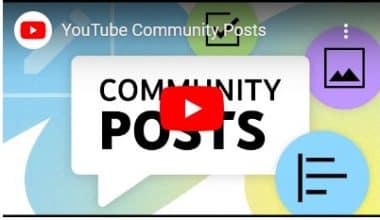One of the best ways I have discovered that can help you promote your company or organization in your neighborhood is to send press releases to local media outlets. Newsworthy stories are constantly sought after by local media outlets, including radio stations, TV channels, and newspapers, for their audience to hear. You can reach a substantial audience of prospective clients or supporters by issuing a well-written press release.
In this comprehensive guide, I’ll share some guidelines on effectively sending press releases via email, reaching out to local media, and connecting with journalists.
Key Points
- Press releases announce newsworthy events or publicly disseminate material information about a company.
- A press release is written by the company’s public relations (PR) department, not reporters or journalists, so it interprets the announcement subjectively. However, it can also include objective facts, such as figures in an earnings report.
- Common types of press releases include new hire press releases, new product press releases, event press releases, business partnership press releases, and crisis management press releases.
What Is a Press Release?
A press release is an official statement (written or recorded) that an organization issues to the news media and beyond. Regardless of the terminology used, the fundamental concept is always the same: a press release, statement, news release, or media release.
While the heading should contain action verbs, the first paragraph should answer the “who,” “what,” “why,” and “where.” The press release should also contain understandable language and a quote.
Press releases are typically brief, lasting at least one or two pages. Companies ultimately want to give enough details so that media outlets have enough content to write about whatever the company is releasing in their articles.
Remember that press releases are visible to your stakeholders and customers as they are published publicly. Therefore, treat a press release as an important piece of marketing content rather than just a means of getting news attention.
How a Press Release Works

A press release is written and sent out by a firm; it is not the result of reporters conducting independent journalistic work, though it is often intended to alert journalists to a potential news story. As a result, readers should consider any bias or subjective interpretations found in press releases. An article’s appearance is usually the best indicator that it is a press release rather than a news report. Generally, there isn’t a byline, and the press release should credit the press office that produced it.
Public relations professionals rely on newswires to deliver their press releases. An assessment of 11 newswire services was carried out in 2012 by Vitis PR, a business-to-business public relations agency serving technology firms among journalists. According to 54% of the journalists questioned, PR Newswire was the most valuable company.
Press Association (PA), at 38%, and Business Wire, at 34%, were the other top-ranked companies.
So, what is these companies’ reach? According to the newswire Agility PR Solutions, “Depending on the size and popularity of the wire, there can be tens of thousands of press releases posted a day.”
More than 440,000 newsrooms, direct feeds, subscribers, and more than 270,000 journalists and influencers, as well as more than 9,000 websites and digital media outlets, are reportedly reached by PR Newswire (PRN). According to the Press Association (PA), “Each week, our journalists and photographers create over a million words of news and feature copy, in addition to 3,000 pictures, and each year, we stream over 30 million hours of live video.”
According to Business Wire, it interacts with over 100,000 media outlets in more than 160 nations. In addition, press releases can be tailored for investor relations (IR), company news, and disclosure requirements.
Types of Press Releases Commonly Used
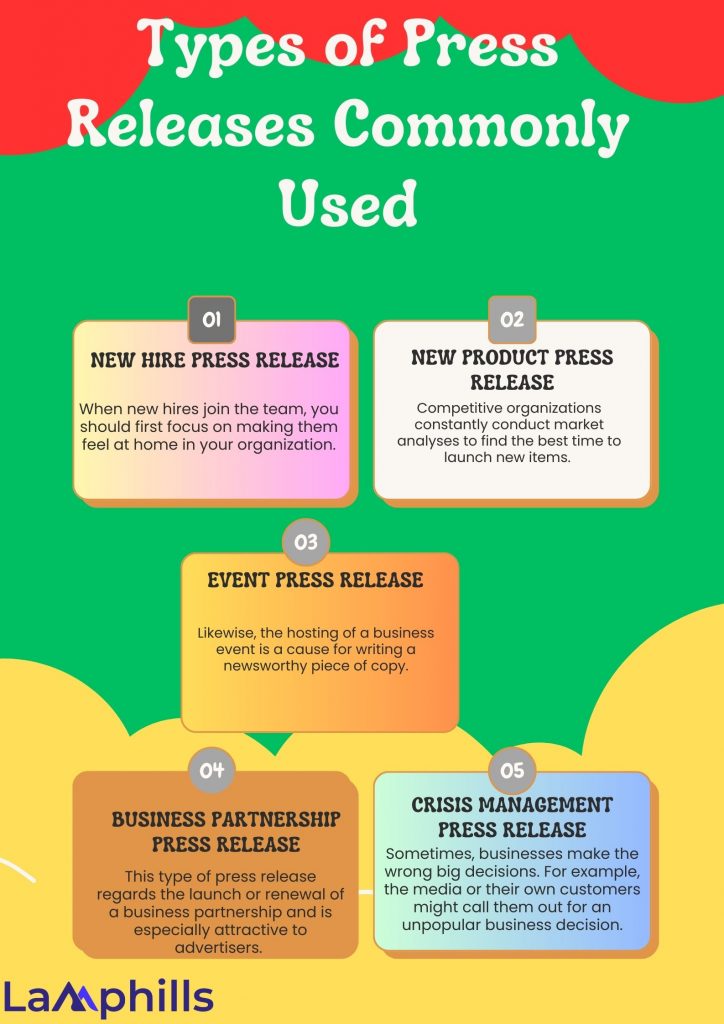
A press release can cover anything significant enough to communicate. My list of the most common types of press releases is inspiring.
#1. New Hire Press Release
When new hires join the team, you should first focus on making them feel at home in your organization.
Composing a press release for an incoming recruit is one approach. This serves as a marketing tool for your organization and showcases your new hire’s qualifications. For example, they might list the press release as a reference or accomplishment on their resume.
If you want to offer this beneficial service to your new hires, include this option in your standard example business contract.
#2. New Product Press Release
Competitive organizations constantly conduct market analyses to find the best time to launch new items. Once the decision has been made, writing a press release is the most effective technique for announcing your new product.
This fulfills multiple functions for you. First, your clients will read the content, immediately informing them and encouraging purchases. Second, journalists might write about it in the news if it is noteworthy enough. Press releases can be considered a particular kind of product marketing strategy.
#3. Event Press Release
Hosting a business event is a cause for writing a newsworthy piece of copy. These types of articles demonstrate your expertise in the topic. For example, if a customer sees that a business has hosted a webinar or conference, they may be more inclined to trust them. This applies whether the customer reads the news on your website or a secondary source.
#4. Business Partnership Press Release
This type of press release regards the launch or renewal of a business partnership and is especially attractive to advertisers. The reason is that those press release materials can be repurposed for marketing campaigns.
For example, a company that invests in a sports club sponsorship may expect to receive several pieces of quality copy as part of the agreement. The value of this is that a press release clause is often included in a standard sports club sponsorship agreement template.
#5. Crisis Management Press Release
Sometimes, businesses make the wrong big decisions. For example, the media or their own customers might call them out for an unpopular business decision.
In this case, a press release offers the offending business a climbing ladder. It allows them to set the record straight in a formal document. One objective is to encourage people to move on quickly.
Why Are Press Releases Important?
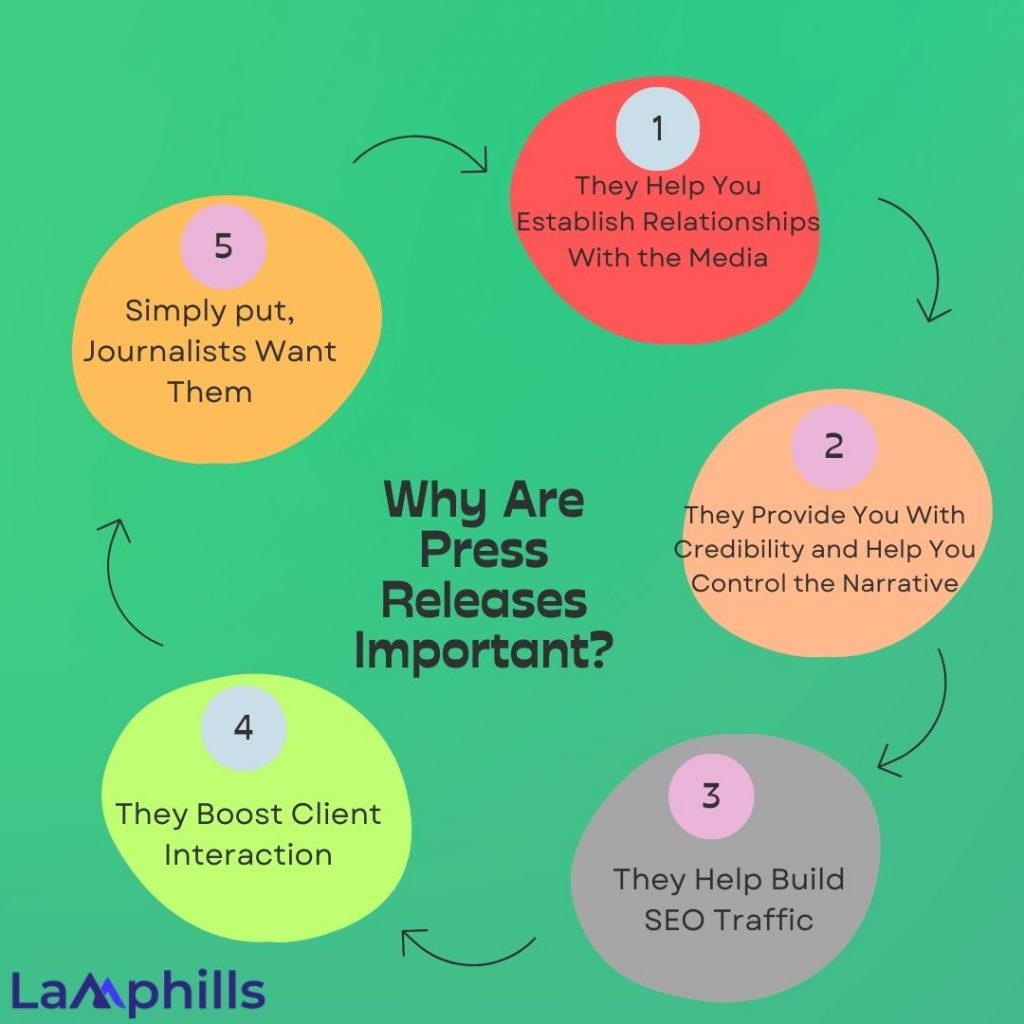
With the advance of social and digital channels to reach audiences and increasingly sophisticated PR analytics available to help PR pros shape their campaigns, it would be easy to write off the press release as an archaic media outreach strategy. But it would also be a mistake.
How so? I’m glad you asked! Here are five reasons the press release is alive and beneficial to any marketing strategy.
#1. They Help You Establish Relationships With the Media
A press release can be an excellent way to start a conversation with a reporter. Journalists are inundated with dozens—sometimes hundreds—of irrelevant pitches and press releases each week. If you reach out to a reporter with a well-written press release relevant to their industry or beat, they will take notice and appreciate it. Even if they can’t cover the topic or product your press release relates to this time, they are more likely to work with you in the future because you’ve established that credibility.
While discussing it, let’s discuss the distinction between a press release and a pitch: Consider a pitch an introduction meant to whet a journalist’s appetite. In pitching, you have to provide enough information about your brand’s current state to get investors’ attention. Pitches are useful for introducing staff members as media experts who can be quoted or for product updates. Send it by email with a brief note that is best expressed as a list with bullets.
A press release, on the other hand, provides a factual summary of anything noteworthy. It should include who, what, where, when, and—above all—why your news matters. Once more, crafting a concise, straightforward press release goes a long way and will assist you in building a reliable relationship with journalists.
#2. They Provide You With Credibility and Help You Control the Narrative
As demonstrated by the 2021 Edelman Trust Barometer Special Report, which shows that most customers believe brand trust is necessary before making a purchase, both the media and consumers regard press releases as reliable sources of data and information.
You can gradually gain credibility with journalists and current and new clients by regularly releasing correct press releases. Spreading good word about oneself is especially helpful for small enterprises starting or expanding.
Press releases additionally facilitate the development of your brand’s story. Besides disseminating crucial firm details, a press release is a tool for managing an internal crisis or unfavorable external coverage. You can clarify internal conflict by offering reliable, honest data to re-establish a positive brand image and public perception.
#3. They Help Build SEO Traffic
A well-written press release using SEO best practices for search algorithms allows search engines to find, match, index, and rank your press release. Having a high-ranking press release on Google (where it’s estimated that around 89,000 searches are conducted every second) and other search engines provides enhanced exposure to current and future customers. So, be thoughtful about how you write and send your press release. Search algorithms are looking for well-written content that naturally incorporates keywords and links.
Your brand will rank higher in search results if you repurpose your press release to produce new content. After all, content is king, so the more timely, relevant content you have, the better. Most press releases can be quickly, simply, and affordably adapted for your website, blog, and social media. For example, converting a press release into a blog post requires far less time than researching and creating new work because all the information is already at your fingertips. Even though you’re giving the same information, you can reach a wider audience by presenting it differently.
#4. They Boost Client Interaction
Because of social media and internet news distributors, your press release can reach a larger audience than ever before. A well-written press release can be distributed to attract attention from present and future clients, rank highly in search results, and encourage direct interaction and social media sharing. You can reach an untapped audience that you may never have considered before.
While you’re at it, whenever and wherever you can integrate multimedia with your press release, such as images, videos, or infographics. Multimedia news releases have higher interaction rates and are more likely to be shared on social media by consumers and the media than text-only releases.
#5. Journalists Want Them
According to Cision’s State of the Media study, journalists continuously search for a good story, and press releases remain one of their primary sources. Not only are press releases the best source for stories, but most journalists (78%) also state that they prefer to see press releases and news announcements from brands.
How To Send a Press Release
I sent out my first press release a couple of years ago, full of anxiety and enthusiasm. Equipped with professional insights and personal tales, I wrote a piece that appealed to readers and journalists alike. I handled the complexities of formatting and distribution channels, ensuring the impact was maximized by drawing on my personal experience.
I have seen how a well-written press release can pique interest and encourage participation in my field. My genuine, unique style drew in viewers and gained their trust. Every stage, from creation to distribution, demonstrated my commitment and creativity, resulting in a well-received campaign and lasting impact.
Writing a press release is not the only thing that makes a release successful. Success or failure depends on how well you develop a media contact list, write your pitch, organize your submissions, distribute your release, and monitor important performance indicators. Here are four easy steps that I applied in sending a press release.
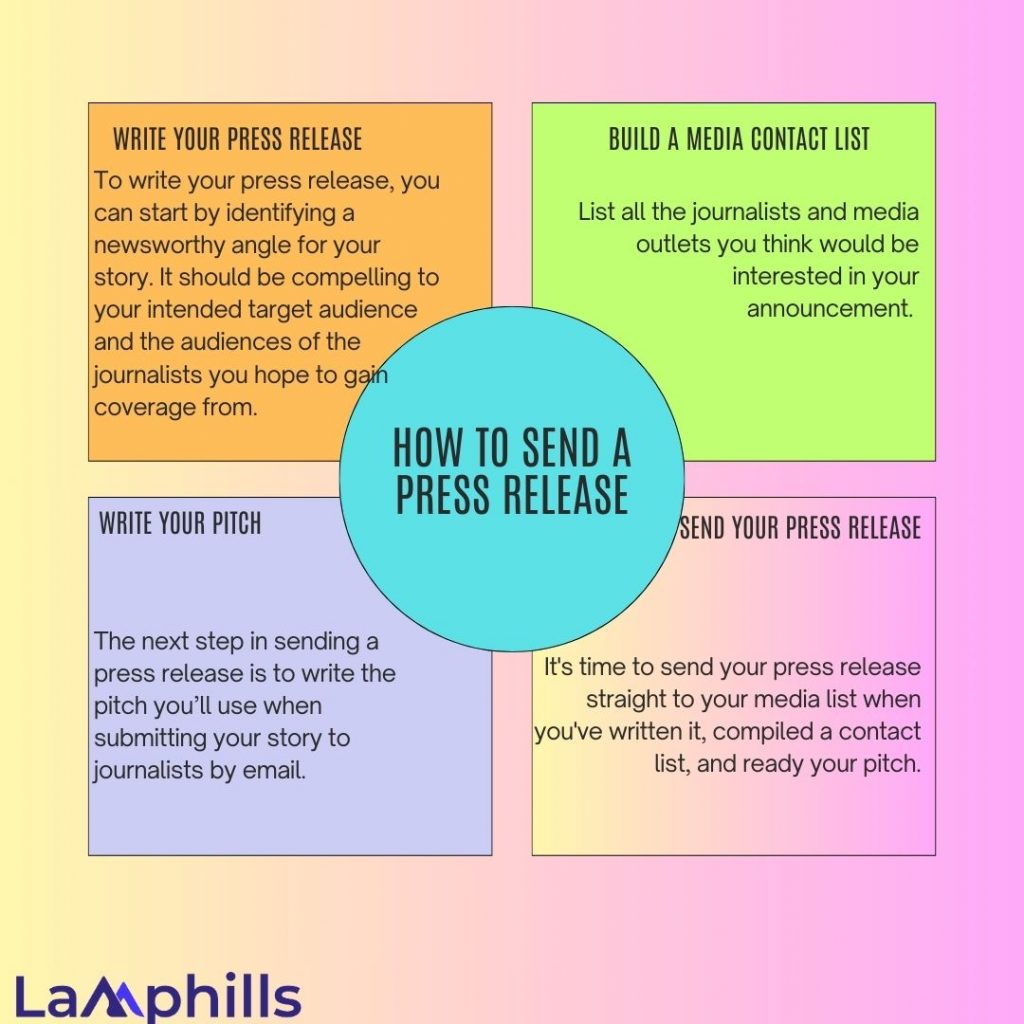
#1. Write Your Press Release
To write your press release, start by identifying a newsworthy angle for your story. It should be compelling to your intended target audience and the audiences of the journalists you hope to gain coverage from. Then, write your announcement using the AP press release format media professionals use.
I will provide a free downloadable press release template to help you save time and effort. It’s preformatted with all the sections needed for standard press release formatting, including a header, headlines, and body
AP Style Press Release Format
#2. Build a Media Contact List
List all the journalists and media outlets you think would be interested in your announcement. Look out for magazines that write for your industry or specialty, writers that cover similar stories regularly, and audiences similar to your target market. Making a spreadsheet with the following columns can be a simple method of assembling this list:
- Media outlet name
- Name of journalist or press contact
- Contact information (email address or URL of web form for submitting a story)
- Information about their audience
- Submission guidelines
Visit the agency’s website to learn who to contact for submitting a press release and to obtain the names of media contacts. If that doesn’t work, try LinkedIn or call the agency to find the reporter’s contact details to whom you should email your release.
Many companies also have a dedicated email address for press releases. When compiling a list of media contacts, consider the following resources:
Traditional news outlets
A traditional news agency is a newspaper, magazine, television channel, radio station, and associated websites. Many list the names of the editorial staff, including email addresses, or offer web forms for online submissions.
Trade publications
Many industries have digital and print trade publication magazines that regularly cover industry-related news. You can search for relevant trade publications on Google and then research their submission guidelines and writers.
Journalists
Many journalists have their websites, publish on sites like Medium, or monetize their articles on platforms like Substack. You can search on these platforms to find journalists who cover stories in your industry or write for similar audiences.
Non-traditional news sources
These include Facebook groups, bloggers, business networking organizations, social media influencers, and other digital groups. While these may not be official news outlets, they are often effective at spreading business news.
In addition, you can use an email address lookup tool to get the email addresses of reporters and other press contacts you believe might be most interested in your story. Prowly provides a media contact database including over a million records, and Hunter is the best free email finder for locating specific journalist addresses. Check out a list of the best email finder tools for more options.
#3. Write Your Pitch
The next step in sending a press release is to write the pitch you’ll use when submitting your story to journalists by email. In your pitch, you should introduce yourself, your company, the press release you submit, and why the journalist should write about it.
When crafting your email template, don’t presume the reporter understands why their readership is interested in your announcement. Make sure the angle of your story—the reason the story should be covered—is included in your proposal. The angle should make it clear to the audience you wish to target why and how your news affects their audience.
For help getting started, use this press release email template:
Lamphills Press Release Email Template
#4. Send Your Press Release
It’s time to send your press release straight to your media list when you’ve written it, compiled a contact list, and ready your pitch. Send journalists an email with your press release and pitch to do this.
Provide links to any photos, videos, and graphics they could use to cover your story to make it easier for them to report your news. Provide a link to your press kit so they can obtain any background information needed to cover your announcement for a story.
Depending on the media outlet and the type of press release, the following general guidelines can assist you in determining how far in advance to send a release:
- Traditional media outlets: Send your press release about a week in advance.
- Trade publications: Send your story three to six months ahead (if possible); editorial calendars for magazine-style publications are planned long in advance.
- Journalists, bloggers, and social influencers: Send a media advisory two to three weeks before an event to invite them to attend. Then, send the press release a week before and follow up with a post-event press announcement.
- Crisis release or trending topics: Send immediately—learn how to write a crisis communication press release.
- Events: Depending on the nature of the occasion and how much time guests and media would need to prepare, you should publish an event press release months, weeks, or days in advance.
Can You Send a Press Release via Email?
Yes, you can send a press release via email. Craft a concise subject line, personalize the email to the recipient, attach the press release document, and include a brief message introducing the news. Provide contact information for further inquiries and invite the recipient to reach out for more information or to schedule an interview. Keep the email brief, informative, and professional.
How To Send a Press Release Via Email
One of the most common ways to send a press release is via email. This is a quick and easy way to get your news in front of journalists, but it’s important to do it right. Here are some tips on how to send a press release via email:
- Start With a Strong Subject Line: The subject line is the first thing journalists will see, so it’s important to make it attention-grabbing and informative. Include the keywords journalists are likely to search for and ensure the subject line accurately reflects the content of your press release.
- Personalize Your Email: Address the email to the appropriate journalist by name, and include a brief introduction of yourself and your organization. This will help personalize the email and make it more likely for the journalist to read it.
- Make Sure Your Email Is Concise and Direct: Journalists rarely have time to read lengthy correspondence because they live busy lives. Ensure your email is no longer than a few paragraphs and gets right to the topic.
- Provide a Press Release Link in Your Email: Rather than adding your press release as an attachment, link it on your website or in a cloud-based storage service. This can prevent your email from being flagged as spam and make it simpler for journalists to obtain your press release.
- Follow-Up: After sending your press release, follow up with journalists to ask about any queries they may have or to inquire about possible interviews. This will raise your chances of having your news covered.
How To Send a Press Release To Local Media

After you have identified the appropriate local media outlets and tailored your press release to their specific needs, it is time to send it. There are several ways to send a press release to local media, including emailing, following up, and sending a physical copy.
#1. Emailing The Press Release
Email is one of the most common ways to send a press release to local media outlets. When emailing your press release, use a clear and attention-grabbing subject line. Address the email to the appropriate contact person and include a brief introduction of yourself and your company.
Attach the press release as a PDF or Word document. Avoid including the entire press release in the body of the email, as this can be overwhelming and may result in your email being ignored or deleted.
#2. Following Up
Following up after sending your press release is important to increase the chances of being picked up by local media. Wait a few days after sending the press release and follow up with a polite and professional email or phone call. In your follow-up, remind the contact person about your press release and ask if they have any questions or need additional information.
#3. Sending A Physical Copy
Sending a physical copy of your press release can be an effective way to get the attention of local media. However, it can be expensive and time-consuming. If you send a physical copy, address it to the appropriate contact person and include a brief cover letter introducing yourself and your company.
How Can I Distribute My Press Release?
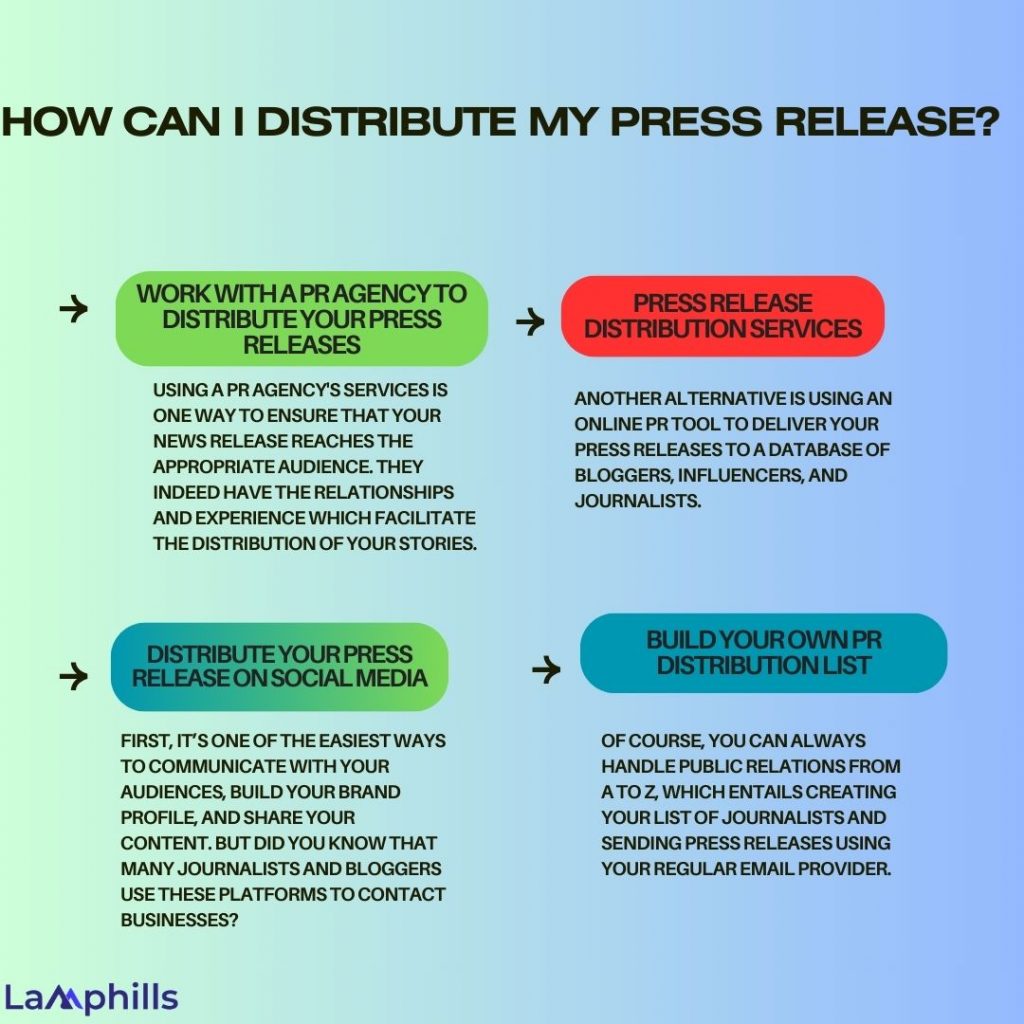
How to distribute your press releases efficiently is as important as writing a good and newsworthy story. If you have a great story to tell but nobody ever hears, you will go unnoticed, and vice versa. Different solutions exist depending on the size of your business and the budget you’re ready to spend on PR. Here are four of them.
#1. Work With a PR Agency to Distribute Your Press Releases
Using a PR agency’s services is one way to ensure that your news release reaches the appropriate audience. They indeed have the relationships and experience which facilitate the distribution of your stories.
Public relations firms are accustomed to collaborating with influencers and journalists. They typically know the appropriate strategy for contacting them. Since they typically understand the rules of journalism, many of these agencies also offer to draft the press release for you, which increases the likelihood that it will be covered.
However, this kind of service has a cost. Not all agencies are inexpensive, especially for small firms. Larger or medium-sized organizations are better suited for this option because they can devote a larger budget to PR.
The fact that journalists don’t always enjoy working with agencies is another dissatisfaction, particularly when it’s a tiny firm. My observations and discussions with journalists reveal that an increasing number would rather work directly with the company’s founder or marketing representative.
#2. Press Release Distribution Services
Another alternative is using an online PR tool to deliver your press releases to a database of bloggers, influencers, and journalists. This kind of technology, such as SEMrush, usually lets you match each press release you want to send out with the appropriate media or individuals by allowing you to select industrial sectors and a geographic location. You can also choose journalists based on the publications they work for.
Using online release distribution platforms is far less expensive than working with an agency. However, some of them cost more than others. Given that each platform offers somewhat distinct services, it’s advisable to research the one that best fits your business.
#3. Distribute Your Press Release on Social Media
First, it’s one of the easiest ways to communicate with your audiences, build your brand profile, and share your content. But did you know that many journalists and bloggers use these platforms to contact businesses? Some even prefer this method because it is fast and easy, and they can find additional information with one click.
Research the people you need to target, follow them on Twitter, and don’t hesitate to send a direct message when you’ve got a story that could interest them.
To increase your chance of getting their attention, regularly like, share, and comment constructively to build a relationship.
#4. Build Your Own PR Distribution List
Of course, you can always handle public relations from A to Z, which entails creating your list of journalists and sending press releases using your regular email provider. Compiling a solid list of connections can take some time, so if you decide to proceed with this approach, you must have the necessary time and personnel resources.
It is, however, the least expensive method of handling your PR.
Your plan might be quite effective because you would have a very targeted audience if you took the proper time to investigate the magazines, blogs, and journalists you’d like to target.
The main inconvenience is that finding contact details can be very hard. Indeed, as they receive thousands of emails every day, journalists and bloggers tend to hide their email addresses. For this reason, it could be worth paying for an affordable platform that provides you with contacts.
Bottom Line
In conclusion, sending a press release to local media outlets can be a powerful tool for businesses to gain visibility, attract media attention, and connect with their local community. By following the step-by-step process I outlined in this ultimate guide, you can increase the chances of having your press release noticed, covered, and shared. Master the art of press release submission and take your local business to new heights of success.
Similar Articles
- PR IN BUSINESS: Types, Functions and Benefits
- User Acquisition: Strategies & How It Works (Detailed Guide)
- HOW TO WRITE A MANIFESTO: The Ultimate Guide



